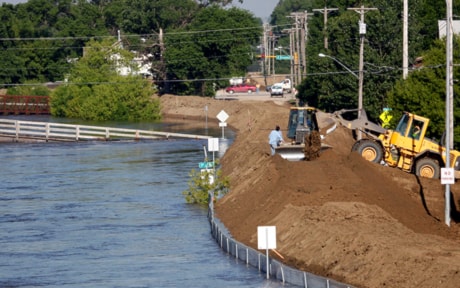MINOT, N.D. — Crews worked furiously Thursday to raise earthen levees in a last-ditch effort to protect at least some neighbourhoods in Minot from the rising Souris River, even as officials acknowledged they can’t stop significant damage to North Dakota’s fourth-largest city.
Trucks and loaders carried clay and dirt to waiting Bobcats that sped to and fro, spreading and tamping the material atop levees that already reached some 15 feet high. The workers and National Guard members were the only people to be seen after as many as 10,000 residents, or about one-fourth of Minot’s population, were evacuated to safety.
Parts of the city were already flooding. One trailer park near the river was under several feet of water. Much of Thursday’s effort focused on protecting critical infrastructure, including sewer and water service; more evacuations could become necessary if either is knocked out by flooding.
Mayor Curt Zimbelman said the sewer and water situation was “under control” but being monitored.
Besides raising levees, Lt. Col. Kendal Bergmann said the U.S. Army Corps of Engineers was drawing down water above the Lake Darling dam now so that later releases don’t have to be as big.
“To protect the city from the water that is coming down, well, we can’t get to it in time,” Bergmann said. “People will be flooded.”
The Souris, swollen from rain and snowmelt, was expected to peak Sunday or Monday several feet above its historic high set in 1881. Gov. Jack Dalrymple warned that releases planned to begin on Thursday would be dramatic.
“In two days’ time, it will be a rapid, rapid rise,” Dalrymple said.
The river, which begins in the Canadian province of Saskatchewan and flows for a short distance though North Dakota, was all but certain to inundate thousands of homes and businesses during the coming week.
“There are 300 people in shelters and the others have found places with family, friends, some rentals,” Zimbelman said. “But for the long term it’s going to be a very difficult situation.”
Some evacuees found themselves scrambling for places to stay in a region that boasts few vacancies in even the best of times, thanks largely to the state’s oil boom.
Aquira Fritt, 23 years old and 7 1/2 months pregnant, planned to spend the night in a van with her boyfriend and 5-year-old son.
“There are no hotel rooms, no campers to rent, nothing,” Fritt said Wednesday, shortly before emergency sirens blared to signal the evacuation deadline. “It’s very stressful and it’s very annoying.”
Her son, Azzyah, considered it an adventure.
“He thinks it’s a campout,” Fritt said. “He’s happy he gets a chance to use his sleeping bag.”
Allan McGeough, executive director of the Minot chapter of the Red Cross, said a few hundred people showed up at the city’s homeless shelters Wednesday night. Both he and Zimbelman expected that number to increase, but Zimbelman said a majority of people have opened their doors to evacuees.
“I tell you what, North Dakotans are pretty good people,” Zimbelman said. “They’re finding places either with friends or neighbours or family. Because there’s not much room in our hotels. They’re full with the oil people.”
The oil boom in western North Dakota has taken off in the last two years, leading to an influx of thousands of workers, some of whom stay in Minot for months at a time and drive 70 miles west to the rigs. Plans are in place to construct so-called man camps to house the workers.
Wendy Howe, executive director of the Minot Convention & Visitors Bureau, said Minot’s 1,820 hotel and motel rooms averaged 80 per cent occupancy through May on the strength of workers from the oil field, tourists from Canada and the city’s location as a regional business hub.
Two shelters have been opened, one at the city’s auditorium and the other at the athletic facility dome at Minot State University, McGeough said. They are equipped with water, food, mental health professionals and nurses, and were nearing the combined capacity of 1,000 Wednesday night. McGeough said others could be opened.
Maj. Gen. David Sprynczyantyk, the North Dakota National Guard commander, said the Guard is working with the federal government on a long-term housing plan for the evacuees. Red Cross volunteers from as far as California were arriving to help, and nearly 500 National Guard soldiers were assisting with traffic control and the evacuation.
Minot is less than 60 miles south of the Canadian border. It was founded in the late 1800s during the construction of the Great Northern Railroad. The economy relies extensively on agriculture, as well as Minot Air Force Base and the recent oil boom in the western part of the state.
———
Associated Press writers Robert Ray in Minot; Wayne Ortman in Sioux Falls, S.D., and Jeffrey McMurray in Chicago contributed to this report.
